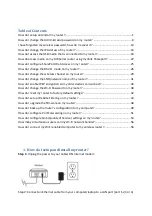
VLAN Support
4-5
Each network client is then assigned one of the two wireless NIC network names. The WL520 device matches packets
transmitted or received to a network name with the associated VLAN. Traffic received by a VLAN is only sent on the wireless
NIC associated with that same VLAN. This eliminates unnecessary traffic on the wireless LAN, conserving bandwidth and
maximizing throughput.
traffic management
traffic management
traffic management
traffic management
In addition to enhancing wireless traffic management, the VLAN-capable WL520 device supports easy assignment of wireless
users to workgroups. In a typical scenario, each user VLAN represents a workgroup; for example, one VLAN could be used for
an EMPLOYEE workgroup and the other, for a GUEST workgroup.
In this scenario, the WL520 device would assign every packet it accepted to a VLAN. Each packet would then be identified as
EMPLOYEE or GUEST, depending on which wireless NIC received it. The WL520 device would insert VLAN headers or “tags”
with identifiers into the packets transmitted on the wired backbone to a network switch.
Finally, the switch would be configured to route packets from the EMPLOYEE workgroup to the appropriate corporate resources
such as printers and servers. Packets from the GUEST workgroup transmitted on the same network as packets from the
EMPLOYEE workgroup, could, in contrast, be restricted to a gateway that allowed access to only the Internet. A member of the
GUEST workgroup could send and receive e-mail and access the Internet, but would be prevented from accessing servers or
hosts on the local corporate network.
typical user vlan configurations
typical user vlan configurations
typical user vlan configurations
typical user vlan configurations
VLANs segment network traffic into workgroups, which enable you to limit broadcast and multicast traffic. Workgroups enable
clients from different VLANs to access different resources using the same network infrastructure. Clients using the same physical
network are limited to those resources available to their workgroup. The three primary scenarios for use of the VLAN support
feature are detailed as follows.
–
Scenario 1: Setting Up Independent VLAN Workgroups (“Tagged” User VLANs)
–
Scenario 2: Setting Up Independent VLAN Workgroups (Tagged & Untagged User VLANs)
–
Scenario 3: Setting Up One VLAN Workgroup (One Tagged VLAN)
setting up independent vlan workgroups (tagged)
setting up independent vlan workgroups (tagged)
setting up independent vlan workgroups (tagged)
setting up independent vlan workgroups (tagged)
The WL520 tags all traffic received from wireless clients transmitted on either the wired or the wireless backbone (see
description of
Wireless Distribution System (WDS)
feature) with a header identifying each packet as belonging to one VLAN
workgroup or another.
To configure this scenario, set up two different workgroups with separate VLAN Identifiers (IDs).
Q
VLAN ID for Wireless NIC in Slot A = a number between 1 and 4094 (per the IEEE 802.1Q standard)
Q
VLAN ID for Wireless NIC in Slot B = a number between 1 and 4094
NOTE:
The number configured for the wireless NIC in Slot A must be different than the number configured for the wireless
NIC in Slot B.
Figure 4-4
Figure 4-4
Figure 4-4
Figure 4-4
VLAN Configuration Screen (Wireless A and Wireless Tagged with Different VLAN IDs)
VLAN Configuration Screen (Wireless A and Wireless Tagged with Different VLAN IDs)
VLAN Configuration Screen (Wireless A and Wireless Tagged with Different VLAN IDs)
VLAN Configuration Screen (Wireless A and Wireless Tagged with Different VLAN IDs)
















































